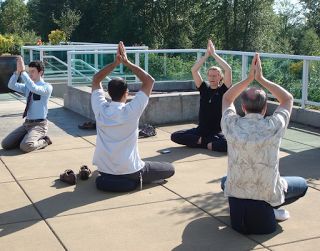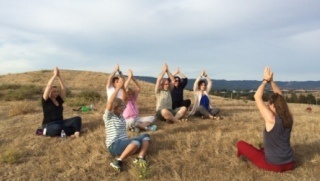Join us on Wednesday mornings from 9-10 for Qigong, $10 drop-in fee. Class is occasionally canceled when I’m out of town.
If you are new to the Samish Center for Mindful Compassion please email amy@amypatteecolvin.com for parking information.
Serving the communities of Samish Island, Anacortes, Fidalgo, La Conner, Mount Vernon, Burlington, Sedro Wooley, Bow, Edison, Alger, Blanchard, Fairhaven, Bellingham.
What Is Qigong?
Qi, pronounced chee, is usually translated to mean the life force that flows through all things in the universe. It is that vital energy that makes life exciting, fun, creative, and joyful. Instinctively we know that the more energy we have, the better we feel.
Gong, pronounced gung, means accomplishment, or skill cultivated through steady practice. The subtle skill of breath control is one of the keys to circulating the flow of internal energy in the body.
Thus the term Qigong may be translated as cultivating energy, as well as breathing exercise. Regular qigong practice cultivates our connection with our life force energy.
The term Qigong may be translated as cultivating energy, as well as breathing-exercise. Regular qigong practice cultivates our connection with our life force energy.
It integrates:
- physical postures, moving or stationary
- breathing techniques
- focused intention
Although qigong is based in Taoism, it is not necessary to learn or believe Taoist philosophy to benefit or practice qigong. People of all ages, life circumstances and spiritual and religious persuasions enjoy qigong.
What physical benefits may arise from practicing the intentional and gentle movements of Qigong?
- Reduce stress, build stamina, increase vitality, and enhance the immune system.
- Improve cardiovascular, respiratory, circulatory, lymphatic and digestive functions.
- Decrease chronic muscle and joint pain.
- Regain and maintain a youthful vitality, promote balance, and help speed recovery from illness.
What other benefits arise from practicing Qigong?
One important long-term effect is that Qigong reestablishes the body/mind/soul connection.
People practice Qigong to support general health, heal their bodies, calm their minds, and reconnect with their spirit. Regular practice of qigong cultivates harmony, emotional stability, inner tranquility, and enjoyment of life while at the same time may reduce stress, anger, anxiety, depression, and rumination.
The class consists of 3 components:
- Gentle flowing warm-up exercises
- One of a variety of standing movement forms, this changes every few months
- A seated form developed by me with an intention on compassion
Wear loose comfortable clothing
$10 fee per class
Learn more about qigong and the benefits of this practice in these articles.
Yi Jin Jing for Vitality: is a one-day workshop that teaches this ancient series, which focuses on infusing soft tissue with qi.
Deep Breathing & Qigong Reduce Anxiety: An informative article on how to use qigong and breathing as an effective stress reduction too; this article includes two easy to implement qigong and breathing exercises.
Embodied Mindfulness Harmonizes Mind & Body: Qigong is an example of an embodied mindfulness practice. It is shown to reduce stress, anxiety, and depression; this article also includes an easy to implement qigong exercise.
I first began practicing Taoist-based compassion meditation in the mid-1990s. The movement and energy-oriented components of this style of meditation were especially attractive to me. Rather than being expected to sit in stillness, students connect with their own internal wisdom and internal energy (qi), and through the process of harmonizing with that energy, movement arises.
This free-flowing movement shares space with stillness and seated meditation, as well as formal movement practices of qigong, mudra, and walking meditation. My teacher, Leong Tan, developed two qigong forms for his students, which I’m pleased to share with you, as well as a modified version of the ancient form called Yi Jin Jing.
Classes are easily accessible to anyone living in the following zip codes: 98221, 98232, 98233, 98257, 98273, 98274, 98284.



